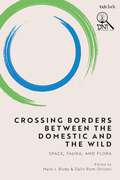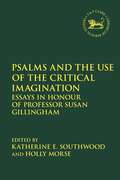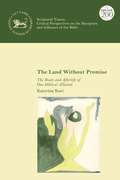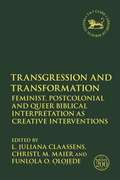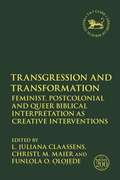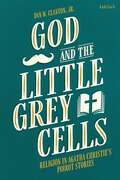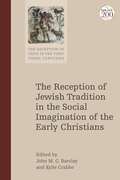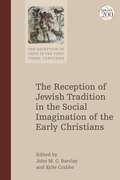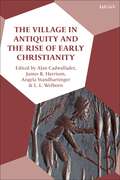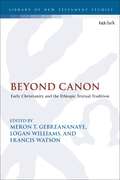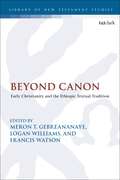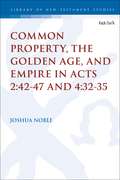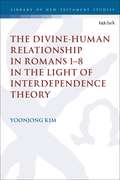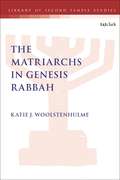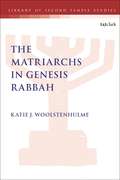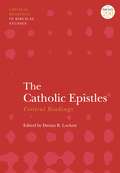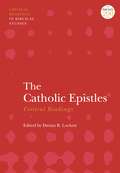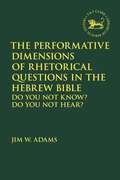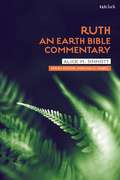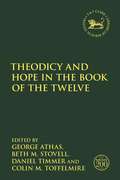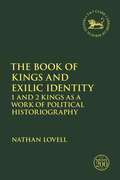- Table View
- List View
Crossing Borders between the Domestic and the Wild: Space, Fauna, and Flora
by Mark J. Boda and Dalit Rom-ShiloniThe present volume searches for different biblical perceptions of the wild, paying particular attention to the significance of fluid boundaries between the domestic and the wild, and to the options of crossing borders between them. Drawing on space, fauna, and flora, scholars investigate the ways biblical authors present the wild and the domestic and their interactions. In its six chapters and two responses, Hebrew Bible scholars, an archaeobotanist, an archaeologist, a geographer, and iconographers join forces to discuss the wild and its portrayals in biblical literature.The discussions bring to light the entire spectrum of real, imagined, metaphorized, and conceptualized forms of the wild that appear in biblical sources, as also in the material culture and agriculture of ancient Israel, and to some extent observe the great gap between biblical observations and modern studies of geography and of mapping that marks the distinctions between “the wilderness” and “the sown.” The book is the first written product presented on two consecutive years (2019, 2020) at the SBL Annual Meetings in the Section: “Nature Imagery and Conceptions of Nature in the Bible.”
Crossing Borders between the Domestic and the Wild: Space, Fauna, and Flora
by Mark J. Boda Dalit Rom-ShiloniThe present volume searches for different biblical perceptions of the wild, paying particular attention to the significance of fluid boundaries between the domestic and the wild, and to the options of crossing borders between them. Drawing on space, fauna, and flora, scholars investigate the ways biblical authors present the wild and the domestic and their interactions. In its six chapters and two responses, Hebrew Bible scholars, an archaeobotanist, an archaeologist, a geographer, and iconographers join forces to discuss the wild and its portrayals in biblical literature.The discussions bring to light the entire spectrum of real, imagined, metaphorized, and conceptualized forms of the wild that appear in biblical sources, as also in the material culture and agriculture of ancient Israel, and to some extent observe the great gap between biblical observations and modern studies of geography and of mapping that marks the distinctions between “the wilderness” and “the sown.” The book is the first written product presented on two consecutive years (2019, 2020) at the SBL Annual Meetings in the Section: “Nature Imagery and Conceptions of Nature in the Bible.”
Psalms and the Use of the Critical Imagination: Essays in Honour of Professor Susan Gillingham (The Library of Hebrew Bible/Old Testament Studies)
The contributors provide fresh insight into the context surrounding the composition and reception of the Psalms, the relationships between the Psalms, and of early audiences who engaged with the material. Close attention is also paid to specific interpretative problems which emerge in the Psalms, both linguistic and theological. Consequently, there is the creation of a more sophisticated historical reconstruction of how the Psalms were used originally and in subsequent periods, opening up challenges and possibilities for scholars through emphasizing the need in critical Psalms scholarship for vitality and imagination.
The Land Without Promise: The Roots and Afterlife of One Biblical Allusion (The Library of Hebrew Bible/Old Testament Studies)
by Katerina KociKaterina Koci charts the development of the promised land motif, starting from its biblical roots and examining its reception over the centuries until the present day. As her corner stone, Koci uses Hans-Georg Gadamer's claim that there are two complementary paths towards understanding and knowledge: science and art. Thus, to be faithful to the creed of the great hermeneutist, Koci ventures into both topics, arguing that while science sets out historical-critical analysis of the promised land motif in the Hebrew Bible and its later receptions, art enriches the interpretation with its literary illustrations. This volume places particular focus on American contexts, since the concept of the promised land is so deeply intertwined with American religious-political mythologies, and with the art of John Steinbeck and Walter Brueggemann in particular. By discussing artistic interpretation in biblical hermeneutics, the context and reception of Genesis 15.7 and Exodus 3.8 in the Hebrew Bible and New Testament, and the history of the promised land motif and its interpretations, Koci argues that artistic receptions of biblical motifs are crucial for biblical scholarship in opening new hermeneutical and thematical horizons.
Transgression and Transformation: Feminist, Postcolonial and Queer Biblical Interpretation as Creative Interventions (The Library of Hebrew Bible/Old Testament Studies)
by L. Juliana Claassens, Christl M. Maier, Funlọla O. Ọlọjẹde and contributorsThis volume on feminist, postcolonial and queer biblical interpretation gathers perspectives from a global body of researchers; in offering innovative interpretations of key texts from the Hebrew Bible, both established and emerging biblical scholars consider the question of how commonplace interpretative practices may be considered to be transgressive in nature. Utilizing innovative strategies, they read against the grain of the text and in support of the marginalized, the subordinated or subaltern others both in the text and in our world today. Important questions regarding power and privilege are constantly raised: whose voices are being heard, and whose interests are being served? Knowing all too well the harm that stereotypical constructions of the Other can do in terms of feeding racism, sexism, homophobia and imperialism in their respective interpretative communities, the essays in this volume interrogate constructions of ethnicity, gender, sexual orientation, and class, both in the text as well as in their respective contexts. By means of these thought-provoking interpretations, the contributors show their commitment not merely the sake of scholarship but to a scholarly ethos, which in some shape or form contributes to the cultivation of more just, equitable societies.
Transgression and Transformation: Feminist, Postcolonial and Queer Biblical Interpretation as Creative Interventions (The Library of Hebrew Bible/Old Testament Studies)
This volume on feminist, postcolonial and queer biblical interpretation gathers perspectives from a global body of researchers; in offering innovative interpretations of key texts from the Hebrew Bible, both established and emerging biblical scholars consider the question of how commonplace interpretative practices may be considered to be transgressive in nature. Utilizing innovative strategies, they read against the grain of the text and in support of the marginalized, the subordinated or subaltern others both in the text and in our world today. Important questions regarding power and privilege are constantly raised: whose voices are being heard, and whose interests are being served? Knowing all too well the harm that stereotypical constructions of the Other can do in terms of feeding racism, sexism, homophobia and imperialism in their respective interpretative communities, the essays in this volume interrogate constructions of ethnicity, gender, sexual orientation, and class, both in the text as well as in their respective contexts. By means of these thought-provoking interpretations, the contributors show their commitment not merely the sake of scholarship but to a scholarly ethos, which in some shape or form contributes to the cultivation of more just, equitable societies.
God and the Little Grey Cells: Religion in Agatha Christie's Poirot Stories
by Dan W. Clanton, Jr.Dan W. Clanton, Jr. examines the presence and use of religion and Bible in Agatha Christie's Hercule Poirot novels and stories and their later interpretations. Clanton begins by situating Christie in her literary, historical, and religious contexts by discussing “Golden Age” crime fiction and Christianity in England in the late 19th-early 20th centuries. He then explores the ways in which Bible is used in Christie's Poirot novels as well as how Christie constructs a religious identity for her little Belgian sleuth. Clanton concludes by asking how non-majority religious cultures are treated in the Poirot canon, including a heterodox Christian movement, Spiritualism, Judaism, and Islam. Throughout, Clanton acknowledges that many people do not encounter Poirot in his original literary contexts. That is, far more people have been exposed to Poirot via “mediated” renderings and interpretations of the stories and novels in various other genres, including radio, films, and TV. As such, the book engages the reception of the stories in these various genres, since the process of adapting the original narrative plots involves, at times, meaningful changes. Capitalizing on the immense and enduring popularity of Poirot across multiple genres and the absence of research on the role of religion and Bible in those stories, this book is a necessary contribution to the field of Christie studies and will be welcomed by her fans as well as scholars of religion, popular culture, literature, and media.
The Reception of Jewish Tradition in the Social Imagination of the Early Christians (The Reception of Jesus in the First Three Centuries)
by John M. G. Barclay, Kylie CrabbeThe contributors to this volume take as their theme the reception of Jewish traditions in early Christianity, and the ways in which the meaning of these traditions changed as they were put to work in new contexts and for new social ends. Special emphasis is placed on the internal variety and malleability of these traditions, which underwent continual processes of change within Judaism, and on reception as an active, strategic, and interested process. All the essays in this volume seek to bring out how acts of reception contribute to the social formation of early Christianity, in its social imagination (its speech and thought about itself) or in its social practices, or both. This volume challenges static notions of tradition and passive ideas of 'reception', stressing creativity and the significance of 'strong' readings of tradition. It thus complicates standard narratives of 'the parting of the ways' between 'Christianity' and 'Judaism', showing how even claims to continuity were bound to make the same different.
The Reception of Jewish Tradition in the Social Imagination of the Early Christians (The Reception of Jesus in the First Three Centuries)
The contributors to this volume take as their theme the reception of Jewish traditions in early Christianity, and the ways in which the meaning of these traditions changed as they were put to work in new contexts and for new social ends. Special emphasis is placed on the internal variety and malleability of these traditions, which underwent continual processes of change within Judaism, and on reception as an active, strategic, and interested process. All the essays in this volume seek to bring out how acts of reception contribute to the social formation of early Christianity, in its social imagination (its speech and thought about itself) or in its social practices, or both. This volume challenges static notions of tradition and passive ideas of 'reception', stressing creativity and the significance of 'strong' readings of tradition. It thus complicates standard narratives of 'the parting of the ways' between 'Christianity' and 'Judaism', showing how even claims to continuity were bound to make the same different.
The Village in Antiquity and the Rise of Early Christianity
by Alan H. Cadwallader, James R. Harrison,Angela Standhartinger and L. L. WelbornA complete geographical and thematic overview of the village in an antiquity and its role in the rise of Christianity. The volume begins with a “state-of-question” introduction by Thomas Robinson, assessing the interrelation of the village and city with the rise of early Christianity. Alan Cadwallader and James R. Harrison then articulate a methodology for future New Testament studies on this topic, employing a series of case studies to illustrate the methodological issues raised.From there contributors explore three areas of village life in different geographical areas, by means of a series of studies, written by experts in each discipline. They discuss the ancient near east (Egypt and Israel), mainland and Isthmian Greece, Asia Minor, and the Italian Peninsula. This geographic focus sheds light upon the villages associated with the biblical cities (Israel; Corinth; Galatia; Ephesus; Philippi; Thessalonica; Rome), including potential insights into the rural nature of the churches located there.A final section of thematic studies explores central issues of local village life (indigenous and imperial cults, funerary culture, and agricultural and economic life).
The Village in Antiquity and the Rise of Early Christianity
by Alan Cadwallader James R. Harrison Angela Standhartinger L. L. WelbornA complete geographical and thematic overview of the village in an antiquity and its role in the rise of Christianity. The volume begins with a “state-of-question” introduction by Thomas Robinson, assessing the interrelation of the village and city with the rise of early Christianity. Alan Cadwallader and James R. Harrison then articulate a methodology for future New Testament studies on this topic, employing a series of case studies to illustrate the methodological issues raised.From there contributors explore three areas of village life in different geographical areas, by means of a series of studies, written by experts in each discipline. They discuss the ancient near east (Egypt and Israel), mainland and Isthmian Greece, Asia Minor, and the Italian Peninsula. This geographic focus sheds light upon the villages associated with the biblical cities (Israel; Corinth; Galatia; Ephesus; Philippi; Thessalonica; Rome), including potential insights into the rural nature of the churches located there.A final section of thematic studies explores central issues of local village life (indigenous and imperial cults, funerary culture, and agricultural and economic life).
Beyond Canon: Early Christianity and the Ethiopic Textual Tradition (The Library of New Testament Studies)
by Meron T. Gebreananaye, Logan Williams and Francis WatsonThis book highlights the significance of a group of five texts excluded from the standard Christian Bible and preserved only in Ge'ez, the classical language of Ethiopia. These texts are crucial for modern scholars due to their significance for a wide range of early readers, as extant fragments of other early translations confirm in most cases. Yet they are also noted for their eventual marginalization and abandonment, as a more restrictive understanding of the biblical canon prevailed – everywhere except in Ethiopia, with its distinctive Christian tradition in which the concept of a “closed canon” is alien. In focusing upon 1 Enoch, Jubilees, the Ascension of Isaiah, the Epistula Apostolorum, and the Apocalypse of Peter, the contributors to this volume group them together as representatives of a time in early Christian history when sacred texts were not limited by a sharply defined canonical boundary. In doing so, this book also highlights the unique and under-appreciated contribution of the Ethiopic Christian Tradition to the study of early Christianity.
Beyond Canon: Early Christianity and the Ethiopic Textual Tradition (The Library of New Testament Studies)
This book highlights the significance of a group of five texts excluded from the standard Christian Bible and preserved only in Ge'ez, the classical language of Ethiopia. These texts are crucial for modern scholars due to their significance for a wide range of early readers, as extant fragments of other early translations confirm in most cases. Yet they are also noted for their eventual marginalization and abandonment, as a more restrictive understanding of the biblical canon prevailed – everywhere except in Ethiopia, with its distinctive Christian tradition in which the concept of a “closed canon” is alien. In focusing upon 1 Enoch, Jubilees, the Ascension of Isaiah, the Epistula Apostolorum, and the Apocalypse of Peter, the contributors to this volume group them together as representatives of a time in early Christian history when sacred texts were not limited by a sharply defined canonical boundary. In doing so, this book also highlights the unique and under-appreciated contribution of the Ethiopic Christian Tradition to the study of early Christianity.
Common Property, the Golden Age, and Empire in Acts 2:42-47 and 4:32-35 (The Library of New Testament Studies)
by Joshua NobleJoshua Noble focuses on the rapid appearance and disappearance in Acts 2 and 4 of the motif that early believers hold all their property in common, and argues that these descriptions function as allusions to the Golden Age myth. Noble suggests Luke's claims that the believers “had all things in common” and that “no one claimed private ownership of any possessions” – a motif that does not appear in any biblical source - rather calls to mind Greek and Roman traditions that the earliest humans lived in utopian conditions, when “no one … possessed any private property, but all things were common.” By analysing sources from Greek, Latin, Jewish and Christian traditions, and reading Acts 2:42–47 and 4:32–35 as Golden Age Allusions, Noble illustrates how Luke's use of the motif of common property is significant for understanding his attitude toward the Roman Empire. Noble suggests that Luke's appeal to this myth accomplishes two things: it characterizes the coming of the Spirit as marking the beginning of a new age, the start of a “universal restoration” that will find its completion at the second coming of Christ; and it creates a contrast between Christ, who has actually brought about this restoration, and the emperors of Rome, who were serially credited with inaugurating a new Golden Age.
Common Property, the Golden Age, and Empire in Acts 2:42-47 and 4:32-35 (The Library of New Testament Studies)
by Joshua NobleJoshua Noble focuses on the rapid appearance and disappearance in Acts 2 and 4 of the motif that early believers hold all their property in common, and argues that these descriptions function as allusions to the Golden Age myth. Noble suggests Luke's claims that the believers “had all things in common” and that “no one claimed private ownership of any possessions” – a motif that does not appear in any biblical source - rather calls to mind Greek and Roman traditions that the earliest humans lived in utopian conditions, when “no one … possessed any private property, but all things were common.” By analysing sources from Greek, Latin, Jewish and Christian traditions, and reading Acts 2:42–47 and 4:32–35 as Golden Age Allusions, Noble illustrates how Luke's use of the motif of common property is significant for understanding his attitude toward the Roman Empire. Noble suggests that Luke's appeal to this myth accomplishes two things: it characterizes the coming of the Spirit as marking the beginning of a new age, the start of a “universal restoration” that will find its completion at the second coming of Christ; and it creates a contrast between Christ, who has actually brought about this restoration, and the emperors of Rome, who were serially credited with inaugurating a new Golden Age.
The Divine-Human Relationship in Romans 1–8 in the Light of Interdependence Theory (The Library of New Testament Studies #635)
by Yoonjong KimYoonjong Kim analyses the divine-human relationship in Paul's theology, focusing on Paul's portrayal of the relationship in Romans 1–8. Kim stresses that previous studies of this relationship have not paid sufficient attention to the fact that it is not static, but rather exhibits progression and development towards a goal. To address the significance of the human agent's role in the relationship, Kim employs a social psychological theory – interdependence theory – offering a consistent analytic framework for diagnosing the interactions in a dyadic relationship in terms of the dependency created by each partner's expectations of outcomes.Kim explores several key stages of the divine-human relationship and the direction in which the relationship develops throughout Romans 1–8, in order to highlight the significance of the human partners in the course of the development. He focuses in particular on betrayal (1.18–3.20), restoration (3.21–26; 5.1–11), the oppressive relationship with Sin (5.12–8.11), and the investment for the future (8.12–39), and concludes that although the foundation of the relationship rests on God's initiative, the divine outworking guides the relationship so that it facilitates mutual participation of the human partners in the restoration and development of the relationship toward the ultimate goal.
The Divine-Human Relationship in Romans 1–8 in the Light of Interdependence Theory (The Library of New Testament Studies)
by Yoonjong KimYoonjong Kim analyses the divine-human relationship in Paul's theology, focusing on Paul's portrayal of the relationship in Romans 1–8. Kim stresses that previous studies of this relationship have not paid sufficient attention to the fact that it is not static, but rather exhibits progression and development towards a goal. To address the significance of the human agent's role in the relationship, Kim employs a social psychological theory – interdependence theory – offering a consistent analytic framework for diagnosing the interactions in a dyadic relationship in terms of the dependency created by each partner's expectations of outcomes.Kim explores several key stages of the divine-human relationship and the direction in which the relationship develops throughout Romans 1–8, in order to highlight the significance of the human partners in the course of the development. He focuses in particular on betrayal (1.18–3.20), restoration (3.21–26; 5.1–11), the oppressive relationship with Sin (5.12–8.11), and the investment for the future (8.12–39), and concludes that although the foundation of the relationship rests on God's initiative, the divine outworking guides the relationship so that it facilitates mutual participation of the human partners in the restoration and development of the relationship toward the ultimate goal.
The Matriarchs in Genesis Rabbah (The Library of Second Temple Studies)
by Katie J. WoolstenhulmeKatie J. Woolstenhulme considers the pertinent questions: Who were 'the matriarchs', and what did the rabbis think about them? Whilst scholarship on the role of women in the Bible and Rabbinic Judaism has increased, the authoritative group of women known as 'the matriarchs' has been neglected. This volume consequently focuses on the role and status of the biblical matriarchs in Genesis Rabbah, the fifth century CE rabbinic commentary on Genesis. Woolstenhulme begins by discussing the nature of midrash and introducing Genesis Rabbah; before exploring the term 'the matriarchs' and its development through early exegetical literature, culminating in the emergence of two definitions of the term in Genesis Rabbah – 'the matriarchs' as the legitimate wives of Israel's patriarchs, and 'the matriarchs' as a reference to Jacob's four wives, who bore Israel's tribal ancestors. She then moves to discuss 'the matriarchal cycle' in Genesis Rabbah with its three stages of barrenness; motherhood; and succession. Finally, Woolstenhulme considers Genesis Rabbah's portrayal of the matriarchs as representatives of the female sex, exploring positive and negative rabbinic attitudes towards women with a focus on piety, prayer, praise, beauty and sexuality, and the matriarchs' exemplification of stereotypical, negative female traits. This volume concludes that for the ancient rabbis, the matriarchs were the historical mothers of Israel, bearing covenant sons, but also the present mothers of Israel, continuing to influence Jewish identity.
The Matriarchs in Genesis Rabbah (The Library of Second Temple Studies)
by Katie J. WoolstenhulmeKatie J. Woolstenhulme considers the pertinent questions: Who were 'the matriarchs', and what did the rabbis think about them? Whilst scholarship on the role of women in the Bible and Rabbinic Judaism has increased, the authoritative group of women known as 'the matriarchs' has been neglected. This volume consequently focuses on the role and status of the biblical matriarchs in Genesis Rabbah, the fifth century CE rabbinic commentary on Genesis. Woolstenhulme begins by discussing the nature of midrash and introducing Genesis Rabbah; before exploring the term 'the matriarchs' and its development through early exegetical literature, culminating in the emergence of two definitions of the term in Genesis Rabbah – 'the matriarchs' as the legitimate wives of Israel's patriarchs, and 'the matriarchs' as a reference to Jacob's four wives, who bore Israel's tribal ancestors. She then moves to discuss 'the matriarchal cycle' in Genesis Rabbah with its three stages of barrenness; motherhood; and succession. Finally, Woolstenhulme considers Genesis Rabbah's portrayal of the matriarchs as representatives of the female sex, exploring positive and negative rabbinic attitudes towards women with a focus on piety, prayer, praise, beauty and sexuality, and the matriarchs' exemplification of stereotypical, negative female traits. This volume concludes that for the ancient rabbis, the matriarchs were the historical mothers of Israel, bearing covenant sons, but also the present mothers of Israel, continuing to influence Jewish identity.
The Catholic Epistles: Critical Readings (T&T Clark Critical Readings in Biblical Studies)
This reference volume aims to be a kind of comprehensive status quaestionis for the Catholic Epistles. Here Darian Lockett has collected some of the highest quality scholarship concentred upon the Letters of James, Peter, ohn, and Jude, creating an introduction and orientation to the wide ranging avenues of scholarly investigation into these New Testament texts all in a single-volume.Divided into four distinct sections, the volume begins with an analysis of the Catholic Epistles as a collection, before moving to discuss historical-critical and theological studies, methodological approaches, and, finally, reception history. Taking care to situate foundational essays in the history of scholarship that may be hard to find or contextualize, Lockett offers a brief introduction to each section and draws each section to a close by providing a list of annotated readings which prompt further study and engagement with some of the last literature to be settled upon in the New Testament canon.
The Catholic Epistles: The Formation Of The Catholic Epistles As A Canonical Collection (T&T Clark Critical Readings in Biblical Studies)
by Darian R. LockettThis reference volume aims to be a kind of comprehensive status quaestionis for the Catholic Epistles. Here Darian Lockett has collected some of the highest quality scholarship concentred upon the Letters of James, Peter, ohn, and Jude, creating an introduction and orientation to the wide ranging avenues of scholarly investigation into these New Testament texts all in a single-volume.Divided into four distinct sections, the volume begins with an analysis of the Catholic Epistles as a collection, before moving to discuss historical-critical and theological studies, methodological approaches, and, finally, reception history. Taking care to situate foundational essays in the history of scholarship that may be hard to find or contextualize, Lockett offers a brief introduction to each section and draws each section to a close by providing a list of annotated readings which prompt further study and engagement with some of the last literature to be settled upon in the New Testament canon.
The Performative Dimensions of Rhetorical Questions in the Hebrew Bible: Do You Not Know? Do You Not Hear? (The Library of Hebrew Bible/Old Testament Studies)
by Jim W. AdamsThis book sets out to describe the multi-dimensional nature and function of rhetorical questions in the Old Testament. Biblical scholars have previously analyzed the use of rhetorical questions in both Testaments, but consistently describe their function in persuasive terms. While this understanding is appropriate in a number of instances, many rhetorical questions do not operate this way, and Jim W. Adams focuses in particular on rhetoric expressing the self-involvement of both the speaker and hearer.Among linguistic philosophers, speech act theory has illuminated the fact that uttering a sentence does not merely convey information; it may also involve the performing of an action. The concept of communicative action provides additional tools to the exegetical process as it points the interpreter beyond the assumption that the use of language is merely for descriptive purposes. Language can also have performative and self-involving dimensions. In relation to speech act theory, linguistic specialists continue to research the nature of rhetorical questions.
Ruth: An Earth Bible Commentary (Earth Bible Commentary)
by Alice M. SinnottThis ecological reading of the book of Ruth takes into account the power which this short story holds, speaking to the whole person by engaging each reader's emotions, imagination, memory, and reason. Alice M. Sinnott demonstrates how the story of Ruth transcends geographical, spatial and historical boundaries by appealing to all concerned with the plight of the Earth. Sinnott highlights the ecological dimensions of the text that scholars have ignored or dismissed in the past, and explores how the narrator gives voice to the way in which the Earth functions throughout the story. Integral to her reading of the text is a concern for Earth and matters such as food, famine, death, harvests, grain, day and night and members of the Earth community. Sinnott considers non-human characters as legitimate determining factors in the structuring of the narrative, and recognizes Earth and members of the Earth community as equally valid subjects. By identifying with these aspects of Ruth, Sinnott is able to read the text with new eyes; and by placing special emphasis in how the narrator depicts the natural world, she reinforces how subjects from that world emerge as integral components.
Theodicy and Hope in the Book of the Twelve (The Library of Hebrew Bible/Old Testament Studies)
This volume explores the themes of theodicy and hope in both individual portions of the Twelve (books and sub-sections) and in the Book of the Twelve as a whole, as the contributors use a diversity of approaches to the text(s) with a particular interest in synchronic perspectives. While these essays regularly engage the mostly redactional scholarship surrounding the Book of Twelve, there is also an examination of various forms of literary analysis of final text forms, and engagement in descriptions of the thematic and theological perspectives of the individual books and of the collection as a whole. The synchronic work in these essays is thus in regular conversation with diachronic research, and as a general rule they take various conclusions of redactional research as a point of departure. The specific themes, theodicy and hope, are key ideas that have provided the opportunity for contributors to explore individual books or sub-sections within the Twelve, and the overarching development (in both historical and literary terms) and deployment of these themes in the collection.
The Book of Kings and Exilic Identity: 1 and 2 Kings as a Work of Political Historiography (The Library of Hebrew Bible/Old Testament Studies)
by Nathan LovellNathan Lovell proposes that 1 and 2 Kings might be read as a work of written history, produced with the explicit purpose of shaping the communal identity of its first readers in the Babylonian exile. By drawing on sociological approaches to the role historiography plays in the construction of political identity, Lovell argues the book of Kings is intended to reconstruct a sense of Israelite identity in the context of these losses, and that the book of Kings moves beyond providing a reason for the exile in Israel's history, and beyond even connecting its exilic audience to that history. The book recalls the past in order to demonstrate what it means to be Israel in the (exilic) present, and to encourage hope for the Israelite nation in the future. After developing a reading strategy for 1–2 Kings that treats the book as a coherent narrative, Lovell examines the construction of Israelite identity within Kings under the headings of covenant, nationhood, land, and rule. In each case he suggests that the narrative of the book creates room for a genuine but temporary expression of Israelite identity in exile: genuine to show that it remains possible for Israel to be Yahweh's people during the exile, but temporary to encourage hope for a future restoration.
